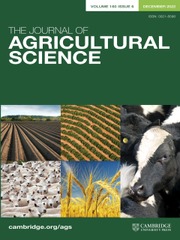Article contents
Note on ‘the significance of the pH determination in the evaluation of quality in silages’
Published online by Cambridge University Press: 27 March 2009
Extract
It is now generally recognized that the pH of a silage is the best single criterion of its quality. In other words, it is regarded as the best single guide to the type of fermentation that has taken place in the mass in the silo and thus serves to indicate the degree of success achieved in the ensilage process, whatever the crop or its stage of growth. For instance, in the case of silages, made with or without molasses, where the pH is at or below 4·0, the silage would be deemed to be of ‘excellent’ quality, that at 4·0-4·5 would be designated ‘good’, that at 4·5–5·0 only ‘moderate’, and at or above the latter figure the silage would be classified as ‘bad’. To get a complete picture of the chemical changes that have taken place and to assess the feeding value of a silage is quite a different matter and is not the object of the present note.
Information
- Type
- Research Article
- Information
- Copyright
- Copyright © Cambridge University Press 1941
References
1 All grass or grass and clover except No. 4 (oat and vetch) and No. 41 (oat and pea).
- 1
- Cited by

